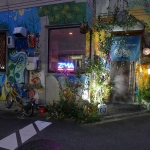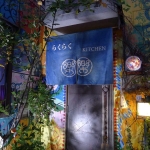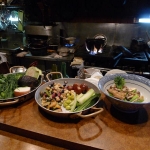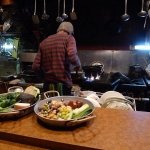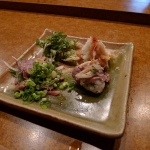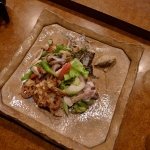Izakaya
When Japanese people want to enjoy drinking in a casual atmosphere and at a reasonable price, the first thing that usually comes to mind is an izakaya. This is where many Japanese themselves head for in the evenings after work, to relax with their co-workers and friends over a couple of drinks and some tasty and inexpensive food. Izakaya are also used for meetings, and more importantly, the after meetings where the real decisions are made.
In any country, there are places where people go to eat (i.e. restaurants and fast food joints) and places they go to drink (bars and pubs), but in Japan there is also a category somewhere in between, casual places where you go to eat and drink: izakaya. Literally, izakaya means ”a sake shop to stay.”
As izakaya mostly cater to locals, they may or may not have an English menu or one with pictures, but if you don’t know what to order, just ask the people sitting next to you. Izakaya are friendly, social places where it is completely OK to strike up a conversation with total strangers, and after a few drinks, even the most reserved Japanese, start displaying surprising language skills. The dishes are generally small and reasonably priced, so order a couple of different things to share with everyone at the table.
The menus are usually quite diverse and they are fun for customers of all ages and genders. Alcohol selections are expansive, featuring a nice assortment of beer, Japanese sake, shochu (distilled liquor), and wine, and the food selections are all encompassing, ranging from Japanese or Western to even Chinese and more. Chain shops are particularly well priced. Some places have tatami mat lined private rooms called ozashiki where four or more people can drink together.
Seating and Ordering
Upon being seated at your table or the counter, you will usually find a small rolled up white towel called an oshibori, that should be used to wipe your hands before eating. Some establishments will even offer hot ones and serve them personally to you, at your table.
First, order an alcoholic beverage. Before food is ordered, the waiter may bring a little appetizer in a small bowl to enjoy at the beginning while drinking. This is called otoshi or tsukidashi which also functions as the cover charge and will be included in your bill for a few hundred yen. It is OK to take your time to order food after this.
Some people judge the character and taste of the izakaya’s food from the contents of the otoshi.
One of the biggest difference between izakaya and restaurant is that the portion of food is very small. These small dishes are called tsumami which are prized locally as something to go with the drinks. Tsumami can vary between from the seasons and places.
To order, catch the waiter’s or waitress’ attention by calling out ”Onegai shimasu!” (meaning ”please”) or ”Sumimasen” (”excuse me”). To pay when you’re finished, call the waiter again, who will lead you to the register and so you can pay.
Food
Izakaya offer many different kinds of food in Japanese cuisine such as yakitori (grilled chicken skewers), agedashi tofu (deep fried tofu with soy sauce and chopped spring onions on top) served in a Japanese broth, kara-age (bite-sized fried chicken) and edamame (boiled and salted soybean pods). Some izakaya offer a combination of all Japanese food restaurants where you can enjoy sashimi, tempura, and yakitori to alcohol drinks such as sake and beer which are a perfect match for these grilled appetizers.
If you come to an izakaya with a group, it is a good idea to order food that is easy for everyone to share, like an assorted (moriawase) yakitori (skewered grilled chicken) plate with several different kinds of yakitori served together or an assorted sashimi plate. In the cold seasons, nabe hotpot dishes are also popular to share. Izakaya specializing in seafood are also common.
After drinking and eating, many people like to order rice based dishes at the end. Some popular choices are ochazuke, where rice, topped with nori (dried seaweed) or umeboshi (pickled Japanese plums) with Japanese tea poured in the bowl, and yaki onigiri (grilled rice balls).
These days, izakaya serve all sorts of things, but the focus is invariably on traditional Japanese dishes that go well with beer and Japanese sake.
Drinks
The Japanese themselves normally start off with a round of draft beer (”nama biiru” – another one of those essential phrases) and may then move on to sake, which can be drunk hot or chilled, and there are hundreds of brands to choose from. Shochu (distilled spirits made from rice, barley or sweet potatoes among other things) is also popular and can be drunk neat, on the rocks, or mixed with water, fruit juices or even oolong tea (this type of mixed shochu is called chu-hi or sour). Naturally, soft drinks are available as well.
Many izakaya offer an all-you-can-drink (nomihodai) style menu. While prices and menus vary, beer, wine, mixed drinks, shochu based drinks and soft drinks are usually included. Sometimes a discount for off-peak hours can be found. This is a great way to have fun and not go broke, especially when out with friends for hours on end (but generally nomihodai has 90-120 min. time limit).
Waraiya
Waraiya is a cozy yakitori style izakaya. The food is exceptionally tasty and the atmosphere is casual and quite lively. Waraiya’s specialty is yakitori which is skewered pieces of chicken and vegetables cooked over a charcoal grill. Yakitori is quite healthy and offers a wide variety of choices loved by adults and children alike. They have a great drink selection and this would be a great place for parties. The service is friendly and the owner does accept off-menu requests. The restaurant’s menu has a lot of unique dishes and is very family friendly. There are lots of fun finger foods for children to enjoy too. Counter and table seating on the 1st floor and table seating on the 2nd and 3rd is available. Whether you go there by yourself or with some friends, you’re sure to enjoy your time at Waraiya.
Open: 17:00-23:30; closed: Mon.
Tel: 075-351-8994
Kitchen Raku Raku
Both an izakaya and an obanzai, many people praise the experience of having chef Akira Mizobuchi prepare a meal for them.
That certainly was true for me. I had one of my favorite meals here when I stayed overnight at Shunkoin Temple at the Myoshinji Temple Complex. See: http://www.shunkoin.com/
Closed every Monday & 3rd Tuesday
http://akirarhythm.wixsite.com/ezez
Kushi Hachi
Kushi Hachi is a reasonably priced izakaya chain in Kyoto well known for its kushikatsu. Kushikatsu is a fried dish that is well suited to Western tastes consisting of a variety of skewered vegetables, fish and meat that is battered and fried. They even have banana kushikatsu with blueberry sauce! They have an enormous variety of menu items and you’re going to want to try them all. They offer everything from sushi to age-dashi-mochi, which is roasted rice cakes served in a Japanese broth. They also have a variety of drinks available. As a refreshing drink, the fresh fruit chu-hi (shochu with soda and then freshly squeezed lemon or lime) is recommended. The menu is in English with lots of pictures and there is definitely something for everyone.
Open: 17:00-23:30 (from 16:30 on Sat. & Sun.)
Tel: 075-212-3999;
Angie
Angie is a restaurant for seafood lovers. The fish is fresh and they have lots of seasonal specialties. Many rare and unique dishes can be found here. One of the most recommended menu items is the roll your own sea urchin (uni) sushi. Another recommendation is their hokke (Atka mackerel), which is a juicy white fish, charcoal grilled and served flat on a plate. Get ready to use your chopsticks! The sashimi is exquisite and their fish hotpot is a nice dish to share. There is a big rectangular table downstairs that just breeds friendship, where many different groups of strangers end up sitting together. It’s also a good place to see what other people are ordering and possibly get some ideas for your own meal. You can find saké from 46 of the 47 prefectures in Japan at Angie and even get a stamp card to let you know which ones you’ve had in the past.
Kyoto has a vibrant nightlife, and the gastronomically inclined on an evening outing should look no further than one of Kyoto’s many izakaya. An integral part of Japanese food culture both high and low, izakaya have long been the place where Japanese people go to unwind after a long day.
Kirakutei
Kyoto-area vegetables are renowned for their unique flavor and aroma, which are highlighted by kyo-ryouri, or traditional Kyoto cooking techniques. Kyo-ryouri emphasizes bringing out the natural flavor of fresh seasonal ingredients, using minimal seasoning and impeccably elegant presentation. Kirakutei’s master chef creates an experience that can be savored with all the senses, Its location near Nijo Castle makes this izakaya easily accessible after a long day of sightseeing.
Reservations: 075-213-1688 (+81-75-213-1688)
For reservations: https://savorjapan.com/0003014833/
Ichimasa
This restaurant offers traditional Japanese dining with a delectable Italian twist. They source their vegetables directly from farms throughout Japan, and their fish is delivered fresh daily from Ainan Port in Ehime prefecture, as well as from Tokyo’s renowned Tsukiji fish market. It should come as no surprise, then, that the specialty at Ichimasa is sashimi, beautifully presented for your viewing—and dining—pleasure.
Momoya
Momoya, specializing in kushiage or fried foods served on skewers, is the perfect place to unwind after work. The large counter, around an open kitchen, lends the eatery an atmosphere that even solo diners can’t help but feel perfectly welcomed in. The open kitchen format also allows the staff to keep track of your progress as you dine, ensuring a constant flow of freshly fried food served crisp and hot; Momoya takes great pride in this process, referring to it as the “parade of skewers”. The extensive beverage list includes a discriminating wine selection that pairs excellently with the seasonal skewered ingredients.
For reservations: https://savorjapan.com/0006022978/
Izakaya Itsuraku
With its upbeat staff and easy atmosphere, Izakaya Itsuraku is the ideal destination whether for a date or a group night out. Besides showcasing a diverse menu emphasizing seasonal dining and featuring a range of specialty vegetables from various regions around Japan, the restaurant also has its own farmland, thus ensuring a selection of local vegetables that is brimming with freshly-picked flavor. On top of delivering the finest ingredients directly from farm to table, Itsuraku offers an extensive sake list providing the perfect complement to the meal. Their daily special comes highly recommended.
For reservations: https://savorjapan.com/result.php?kw=Izakaya+Itsuraku&x=18&y=14
Roman-ya
For a nostalgic taste of Showa Japan, look no further than Roman-ya. The retro izakaya’s private rooms, perfect for groups both large and small, are adorned with colorful signs and posters that echo with times gone by. Roman-ya is renowned for its satsuma chirandori, a special type of poultry from the Satsuma area in Kyushu. Raised four to ten times longer than the average chicken, this meat possesses a firmer texture and more robust, fuller flavor. Savor their “momo-yaki jonetsuen” chicken thighs, grilled until golden at high temperature. Adventurous souls might sample the basashi, or horse sashimi, a classic Showa-era dish sourced directly from the Kumamoto area, where it is a local specialty.
Don Rokkaku
Discerning night owls will fall in love with Don Rokkaku, which keeps its doors open until 5 a.m. With its huge red lantern and shop curtain outside the door, the izakaya is easy to spot from the street. Head chef Okamoto, who has been cooking for over 50 years, uses his hard-earned decades of experience to draw the best flavor out of local ingredients. One prime example is the coveted dote-ni, or beef tendon stew, for which he eschews the traditional red miso base for an exquisite Kyoto-style sweet white miso. Don Rokkaku features counter seating on the first floor and tatami seating for groups on the second—get there before the stew runs out.
Sajiki
Saijiki, located close to the Imperial Palace, is perfect for group dinners. The izakaya has plenty of private rooms for parties of 2 to 12, including a room featuring a gorgeous traditional entaku round table. The glowing ambient lighting inside evokes a cozy feeling, particularly in the winter when Sajiki serves up motsu nabe, a warming winter hot pot dish made with Saikyo miso, a type of golden yellow miso from the Kyoto area that is as naturally sweet as its color.
More information and reservations: https://gurunavi.com/en/c490200/rst/#restaurantdetail
Enmadou
For a Kyoto dining experience like no other, be sure to visit the refined yet reasonably priced Enmado, located in a traditional townhouse over a century old. At Enmado, choose between counter seating or one of the many private rooms, each uniquely decorated with elegance. The specialty here is the tebasaki bomber, crispy grilled chicken wings that tickle the tongue with flavors both salty and sweet. The wafu pasta, basted in a rich, decadent uni cream sauce and accented with salty bits of tobiko caviar, is another highlight of the menu. As if that were not enough, Enmado also specializes in traditional obanzai ryouri and has its own homemade tofu. The extensive dessert list includes local sweets such as Kyoto matcha parfait and ice cream incorporating yatsuhashi, a beloved confection of cinnamon, sugar and mochi that is both locally famous and undeniably delectable.
For reservations: https://savorjapan.com/0006039959/
Kyoasobi Gion
Gion is known both for its famous geisha district and for its peerless cuisine. After a day on the lookout for geiko (Kyoto geisha) and their maiko apprentices, visit the Gion location of Yakiniku Dining Kyoasobi. With intimate lighting and counter, table, and even sofa seating, the stylish, relaxed interior of Kyoasobi captures the luxurious essence of the Gion district. The house dish is Gion tsukune, succulent homemade chicken meatballs; the elegantly presented Tamba chidori tataki, carefully grilled over high-temperature, smokeless Binchotan coal that draws out its natural flavor, has crisp roasted skin and a medium rare center. Kyoasobi also furnishes an extensive selection of local beers and sake, each a fitting complement to chicken so fresh that it may actually be served raw.
https://vie-group.co.jp/en/business/eat/
http://hitosara.com/0006016239/


